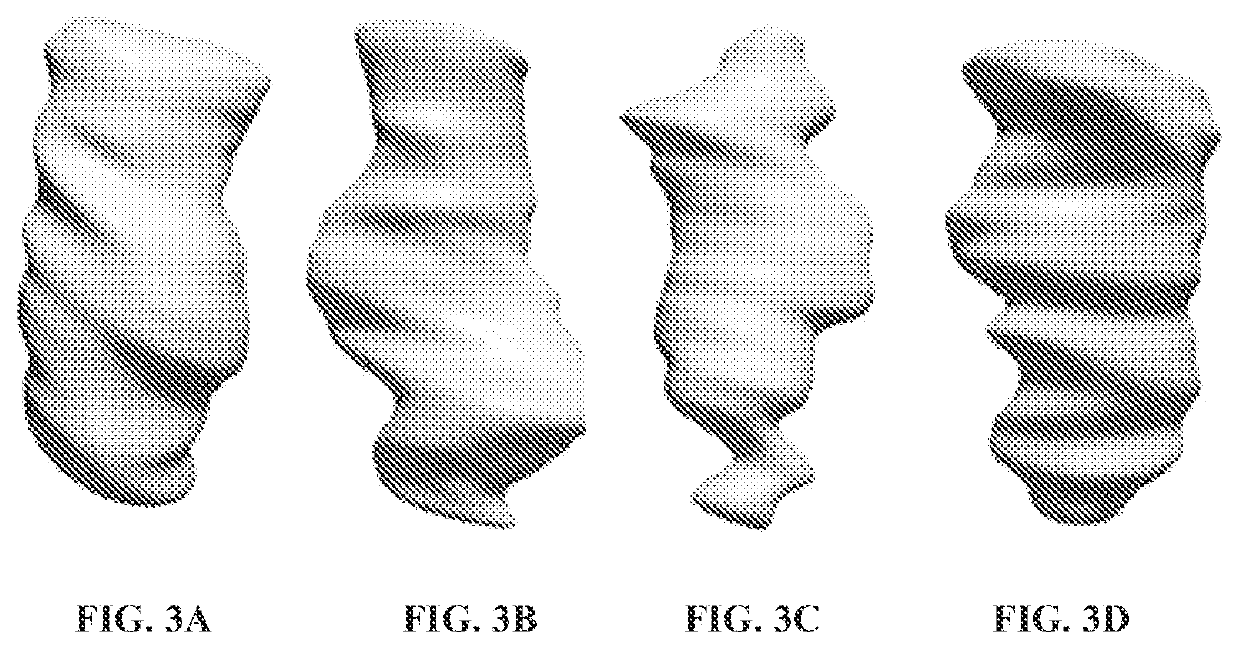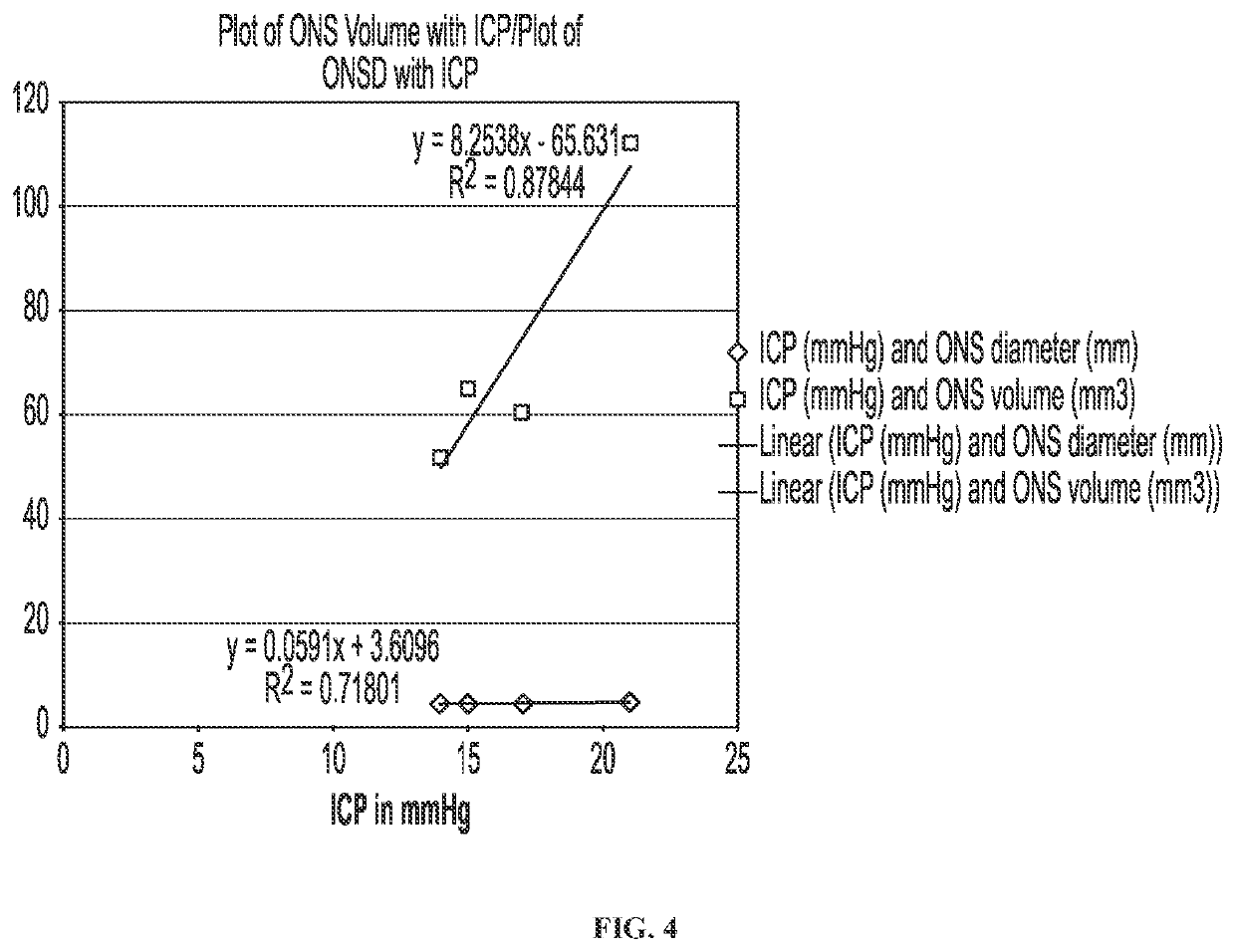Systems and methods for detecting intracranial pressure and volume
a system and volume detection technology, applied in the field of systems and methods for detecting brain injuries, can solve the problems of significant impairment of a person's ability to function physically, cognitively and psychologically, increased risk of repeated head injuries in individuals with mtbi, and increased risk of brain damage to a second tim
- Summary
- Abstract
- Description
- Claims
- Application Information
AI Technical Summary
Benefits of technology
Problems solved by technology
Method used
Image
Examples
example 1
Cadaveric Trials
[0108]Materials and Methods
[0109]A cadaveric trial was chosen to study the speed at which the ONS dilates with increasing ICP. An invasive intracranial monitor was used to monitor the ICP as well as instill saline into the ventricle of the cadaver (increasing ICP) while simultaneous US scans of the ONS were performed to obtain 2D ONSD measurements.
[0110]Results
[0111]The ONS dilates near simultaneously with instillation of fluid into the intracranial space (ICS). The percent change in ONSD with change in ICP levels after saline instillation at different intervals. On an average, a 90% and 5% change in ICP and ONSD was recorded during the entire trial. Although the change in ONS dilation is simultaneous with ICP increase, the behavior of ONS dilation (varies from 4.2 mm to 5.3 mm) is less dynamic than change in ICP levels (4 cm / H2O to 34 cm / H2O). Therefore, there is an impetus to develop sensitive and multiple biomarkers than a traditional 2D ONSD to accurately detect ...
example 2
Human Trials
[0112]Materials and Methods
[0113]Data acquisition from 5 patients has been completed to date.
[0114]Trauma patients, who were both sedated and on mechanical ventilation, with recent brain injuries were potential subjects in this protocol. ICP measurements were obtained from an invasively placed intracranial monitor. 2D US measurements of the ONS were obtained using a SonoSite Micromaxx US system (L38 10-5 MHz linear transducer). 3D modeling of the ONS was made using a combination of the L38 transducer coupled to a sensor, which maps the position and orientation of the transducer during the US exam. The position and time-corrected US images were then automatically re-formatted to provide US data at any orthogonal or non-orthogonal slice plane. Using a 2½ D approach for surface reconstruction, a 3D surface model of the ONS was generated from the segmented boundary slices. The ONSD measurements derived from a 2D image and from the 3D model of the ONS were compared to the dir...
example 3
3D Modeling of the Optic Nerve Sheath (ONS)
[0117]Materials and Methods
[0118]A 2D ultrasound transducer was used according to the manufacturer's instructions. The MetriTrack™ ultrasound system was used. This approach allows minimal-overhead 3D scanning with an innovative add-on device that is clipped onto standard ultra sound probes, near-instantaneous calibration, and has the potential to guide a variety of other image-guided interventions. Current version of CGM software version will perform “hands-off” 3D ultrasound reconstruction without system / operator interaction (FIGS. 6A and 6B). This probe tracking and reconstruction is performed with sensors entirely integrated into a clip-on bracket for handheld US probes (FIGS. 6A and 6B), with stereo cameras observing the environment (both on the patient and the surrounding background) and extract features that are salient enough to support probe trajectory reconstruction. Furthermore, in adverse conditions 3D environment surfaces can be...
PUM
 Login to View More
Login to View More Abstract
Description
Claims
Application Information
 Login to View More
Login to View More - R&D
- Intellectual Property
- Life Sciences
- Materials
- Tech Scout
- Unparalleled Data Quality
- Higher Quality Content
- 60% Fewer Hallucinations
Browse by: Latest US Patents, China's latest patents, Technical Efficacy Thesaurus, Application Domain, Technology Topic, Popular Technical Reports.
© 2025 PatSnap. All rights reserved.Legal|Privacy policy|Modern Slavery Act Transparency Statement|Sitemap|About US| Contact US: help@patsnap.com



